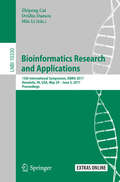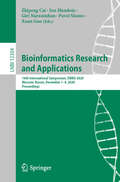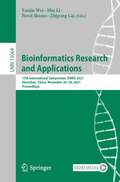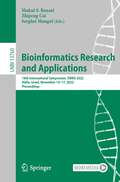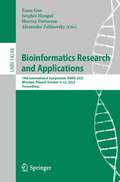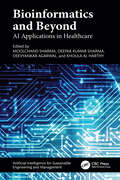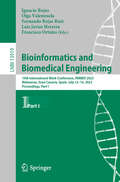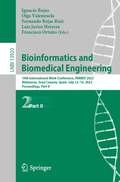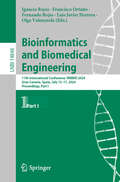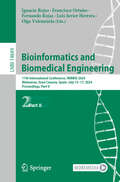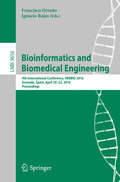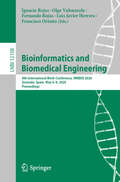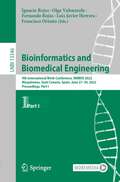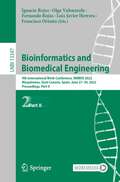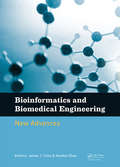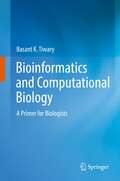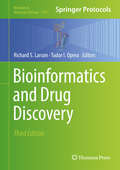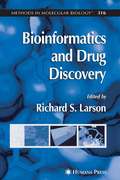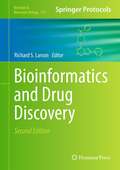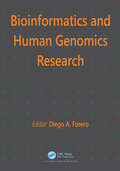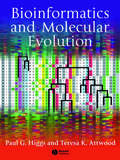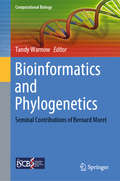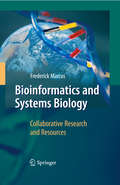- Table View
- List View
Bioinformatics Research and Applications: 13th International Symposium, ISBRA 2017, Honolulu, HI, USA, May 29 – June 2, 2017, Proceedings (Lecture Notes in Computer Science #10330)
by Zhipeng Cai, Ovidiu Daescu and Min LiThis book constitutes the proceedings of the 13th International Symposium on Bioinformatics Research and Applications, ISBRA 2017, held in Honolulu, HI, USA, in May/June 2017. The 27 full papers presented together with 18 short papers and 24 invited abstracts were carefully reviewed and selected from 131 submissions. They cover topics such as: biomarker discovery; biomedical databases and data integration; biomedical text mining and ortologies; biomolecular imaging; comparative genomics; computational genetic epidemiology; computational proteomics; data mining and visualization; gene expression analysis; genome analysis; high-performance bio-computing; metagenomics; molecular evolution; molecular modelling and simulation; next-generation sequencing data analysis; pattern discovery and classification; population genetics; software tools and applications; structural biology; and systems biology.
Bioinformatics Research and Applications: 16th International Symposium, ISBRA 2020, Moscow, Russia, December 1–4, 2020, Proceedings (Lecture Notes in Computer Science #12304)
by Xuan Guo Ion Mandoiu Pavel Skums Zhipeng Cai Giri NarasimhanThis book constitutes the proceedings of the 16th International Symposium on Bioinformatics Research and Applications, ISBRA 2020, held in Moscow, Russia, in December 2020. The 23 full papers and 18 short papers presented in this book were carefully reviewed and selected from 131 submissions. They were organized in topical sections named: genome analysis; systems biology; computational proteomics; machine and deep learning; and data analysis and methodology.
Bioinformatics Research and Applications: 17th International Symposium, ISBRA 2021, Shenzhen, China, November 26–28, 2021, Proceedings (Lecture Notes in Computer Science #13064)
by Min Li Pavel Skums Zhipeng Cai Yanjie WeiThis book constitutes the proceedings of the 17th International Symposium on Bioinformatics Research and Applications, ISBRA 2021, held in Shenzhen, China, in November 2021. The 51 full papers presented in this book were carefully reviewed and selected from 135 submissions. They were organized in topical sections named: AI and disease; computational proteomics; biomedical imaging; drug screening and drug-drug interaction prediction; Biomedical data; sequencing data analysis.
Bioinformatics Research and Applications: 18th International Symposium, ISBRA 2022, Haifa, Israel, November 14–17, 2022, Proceedings (Lecture Notes in Computer Science #13760)
by Zhipeng Cai Serghei Mangul Mukul S. BansalThis book constitutes the proceedings of the 18th International Symposium on Bioinformatics Research and Applications, ISBRA 2022, held in Haifa, Israel, in November 14–17, 2022.The 30 full papers and 4 short papers presented in this book were carefully reviewed and selected from 72 submissions. They were organized in topical sections named: AI and disease; computational proteomics; biomedical imaging; drug screening and drug-drug interaction prediction; Biomedical data; sequencing data analysis.
Bioinformatics Research and Applications: 19th International Symposium, ISBRA 2023, Wrocław, Poland, October 9–12, 2023, Proceedings (Lecture Notes in Computer Science #14248)
by Xuan Guo Alexander Zelikovsky Serghei Mangul Murray PattersonThis book constitutes the refereed proceedings of the 19th International Symposium on Bioinformatics Research and Applications, ISBRA 2023, held in Wrocław, Poland, during October 9–12, 2023.The 28 full papers and 16 short papers included in this book were carefully reviewed and selected from 89 submissions. They were organized in topical sections as follows: reconciling inconsistent molecular structures from biochemical databases; radiology report generation via visual recalibration and context gating-aware; sequence-based nanobody-antigen binding prediction; and hist2Vec: kernel-based embeddings for biological sequence classification.
Bioinformatics Techniques for Drug Discovery: Applications For Complex Diseases (SpringerBriefs in Computer Science)
by Ajay Kumar Aman Chandra Kaushik Shiv Bharadwaj Ravi Chaudhary Shakti SahiThe application of bioinformatics approaches in drug design involves an interdisciplinary array of sophisticated techniques and software tools to elucidate hidden or complex biological data. This work reviews the latest bioinformatics approaches used for drug discovery. The text covers ligand-based and structure-based approaches for computer-aided drug design, 3D pharmacophore modeling, molecular dynamics simulation, the thermodynamics of ligand−receptor and ligand−enzyme association, thermodynamic characterization and optimization, and techniques for computational genomics and proteomics.
Bioinformatics and Beyond: AI Applications in Healthcare (Artificial Intelligence for Sustainable Engineering and Management)
by Moolchand Sharma Deevyankar Agarwal Deepak Kumar Sharma Khoula Al HarthyThis book is a comprehensive exploration of the dynamic interplay between bioinformatics and artificial intelligence (AI) within the healthcare landscape. This book introduces readers to the foundational principles of bioinformatics and AI, elucidating their integration and collaborative potential.Bioinformatics and Beyond: AI Applications in Healthcare explores the transformative impact of data-driven insights, showcasing the applications of machine learning in diagnostics, personalized medicine, and genomic advancements. The book unveils the pivotal role AI plays in accelerating pharmaceutical research. Moreover, it addresses the practical implementation of AI in clinical decision support systems, while also critically examining challenges and ethical considerations associated with these technologies. Finally, the book looks toward the future, envisioning emerging trends and technologies that promise to reshape the future of healthcare. Aimed at professionals, researchers, and students across diverse disciplines, this book serves as an invaluable guide to understanding and navigating the evolving landscape of AI applications in healthcare.This book is tailored to meet the needs of scientists, researchers, practitioners, professionals, and educators actively engaged in the realms of bioinformatics, artificial intelligence, and healthcare. It will be an indispensable resource for those seeking advanced strategies to address challenges and harness opportunities in the rapidly evolving fields of medical and biomedical research.
Bioinformatics and Biomedical Engineering: 10th International Work-Conference, IWBBIO 2023, Meloneras, Gran Canaria, Spain, July 12–14, 2023, Proceedings, Part I (Lecture Notes in Computer Science #13919)
by Ignacio Rojas Francisco Ortuño Olga Valenzuela Luis Javier Herrera Fernando Rojas RuizThis volume constitutes the proceedings of the 10th International Work-Conference on IWBBIO 2023, held in Meloneras, Gran Canaria, Spain, during July 12-14, 2022. The total of 79 papers presented in the proceedings, was carefully reviewed and selected from 209 submissions. The papers cove the latest ideas and realizations in the foundations, theory, models, and applications for interdisciplinary and multidisciplinary research encompassing disciplines of computer science, mathematics, statistics, biology, bioinformatics, and biomedicine.
Bioinformatics and Biomedical Engineering: 10th International Work-Conference, IWBBIO 2023, Meloneras, Gran Canaria, Spain, July 12–14, 2023, Proceedings, Part II (Lecture Notes in Computer Science #13920)
by Ignacio Rojas Francisco Ortuño Olga Valenzuela Luis Javier Herrera Fernando Rojas RuizThis volume constitutes the proceedings of the 10th International Work-Conference on IWBBIO 2023, held in Meloneras, Gran Canaria, Spain, during July 12-14, 2022. The total of 79 papers presented in the proceedings, was carefully reviewed and selected from 209 submissions. The papers cove the latest ideas and realizations in the foundations, theory, models, and applications for interdisciplinary and multidisciplinary research encompassing disciplines of computer science, mathematics, statistics, biology, bioinformatics, and biomedicine.
Bioinformatics and Biomedical Engineering: 11th International Conference, IWBBIO 2024, Meloneras, Gran Canaria, Spain, July 15–17, 2024, Proceedings, Part I (Lecture Notes in Computer Science #14848)
by Ignacio Rojas Francisco Ortuño Olga Valenzuela Fernando Rojas Luis Javier HerreraThis volume constitutes the proceedings of the 11th International Work-Conference on IWBBIO 2023, held in Gran Canaria, Spain, during July 15-17, 2022. The 54 full papers were carefully reviewed and selected from 148 submissions. They were organized in the following topical sections: Biomarker Identification, Biomedical Engineering, Biomedical Signal Analysis, E-Health.
Bioinformatics and Biomedical Engineering: 11th International Conference, IWBBIO 2024, Meloneras, Gran Canaria, Spain, July 15–17, 2024, Proceedings, Part II (Lecture Notes in Computer Science #14849)
by Ignacio Rojas Francisco Ortuño Olga Valenzuela Fernando Rojas Luis Javier HerreraThis volume constitutes the proceedings of the 11th International Work-Conference on IWBBIO 2023, held in Meloneras, Gran Canaria, Spain, during July 15-17, 2022. The 54 full papers were carefully reviewed and selected from 148 submissions. They were organized in the following topical sections: Healthcare and Diseases, Machine Learning in Bioinformatics, New Advances in Deep Learning in Bioinformatics and Biomedicine, Novel Methodologies and Applications in Bioinformatics and Biomedicine.
Bioinformatics and Biomedical Engineering: 4th International Conference, IWBBIO 2016, Granada, Spain, April 20-22, 2016, Proceedings (Lecture Notes in Computer Science #9656)
by Ignacio Rojas Francisco OrtuñoThis book constitutes the refereed proceedings of the 4th International Conference on Bioinformatics and Biomedical Engineering, IWBBIO 2016, held in Granada, Spain, in April 2016. The 69 papers presented were carefully reviewed and selected from 286 submissions. The scope of the conference spans the following areas: bioinformatics for healthcare and diseases; biomedical image analysis; biomedical signal analysis; computational systems for modeling biological processes; eHealth; tools for next generation sequencing data analysis; assistive technology for people with neuromotor disorders; fundamentals of biological dynamics and maximization of the information extraction from the experiments in the biological systems; high performance computing in bioinformatics, computational biology and computational chemistry; human behavior monitoring, analysis and understanding; pattern recognition and machine learning in the -omics sciences; and resources for bioinformatics.
Bioinformatics and Biomedical Engineering: 8th International Work-Conference, IWBBIO 2020, Granada, Spain, May 6–8, 2020, Proceedings (Lecture Notes in Computer Science #12108)
by Ignacio Rojas Francisco Ortuño Olga Valenzuela Fernando Rojas Luis Javier HerreraThis volume constitutes the proceedings of the 8th International Work-Conference on IWBBIO 2020, held in Granada, Spain, in May 2020. The total of 73papers presented in the proceedings, was carefully reviewed and selected from 241 submissions. The papers are organized in topical sections as follows: Biomarker Identification; Biomedical Engineering; Biomedical Signal Analysis; Bio-Nanotechnology; Computational Approaches for Drug Design and Personalized Medicine; Computational Proteomics and Protein-Protein Interactions; Data Mining from UV/VIS/NIR Imaging and Spectrophotometry; E-Health Technology, Services and Applications; Evolving Towards Digital Twins in Healthcare (EDITH); High Performance in Bioinformatics; High-Throughput Genomics: Bioinformatic Tools and Medical Applications; Machine Learning in Bioinformatics; Medical Image Processing; Simulation and Visualization of Biological Systems.
Bioinformatics and Biomedical Engineering: 9th International Work-Conference, IWBBIO 2022, Maspalomas, Gran Canaria, Spain, June 27–30, 2022, Proceedings, Part I (Lecture Notes in Computer Science #13346)
by Ignacio Rojas Francisco Ortuño Olga Valenzuela Fernando Rojas Luis Javier HerreraThis volume constitutes the proceedings of the 9th International Work-Conference on IWBBIO 2020, held in Maspalomas, Gran Canaria, Spain, in June 2022. The total of 75 papers presented in the proceedings, was carefully reviewed and selected from 212 submissions. The papers cover the latest ideas and realizations in the foundations, theory, models, and applications for interdisciplinary and multidisciplinary research encompassing disciplines of computer science, mathematics, statistics, biology, bioinformatics, and biomedicine.
Bioinformatics and Biomedical Engineering: 9th International Work-Conference, IWBBIO 2022, Maspalomas, Gran Canaria, Spain, June 27–30, 2022, Proceedings, Part II (Lecture Notes in Computer Science #13347)
by Ignacio Rojas Francisco Ortuño Olga Valenzuela Fernando Rojas Luis Javier HerreraThis volume constitutes the proceedings of the 9th International Work-Conference on IWBBIO 2020, held in Maspalomas, Gran Canaria, Spain, in June 2022. The total of 75 papers presented in the proceedings, was carefully reviewed and selected from 212 submissions. The papers cover the latest ideas and realizations in the foundations, theory, models, and applications for interdisciplinary and multidisciplinary research encompassing disciplines of computer science, mathematics, statistics, biology, bioinformatics, and biomedicine.
Bioinformatics and Biomedical Engineering: Proceedings of the 9th International Conference on Bioinformatics and Biomedical Engineering (iCBBE 2015), Shanghai, China, 18-20 September 2015
by James J. Chou Huaibei ZhouThe 9th International Conference on Bioinformatics and Biomedical Engineering (iCBBE 2015) was held on September 18-20, 2015, Shanghai, China. This proceedings volume assembles papers from various professionals engaged in the fields of Biomedical Engineering, Bioinformatics and Computational Biology. The conference had special sessio
Bioinformatics and Computational Biology: A Primer for Biologists
by Basant K. TiwaryThis textbook introduces fundamental concepts of bioinformatics and computational biology to the students and researchers in biology, medicine, veterinary science, agriculture, and bioengineering . The respective chapters provide detailed information on biological databases, sequence alignment, molecular evolution, next-generation sequencing, systems biology, and statistical computing using R. The book also presents a case-based discussion on clinical, veterinary, agricultural bioinformatics, and computational bioengineering for application-based learning in the respective fields. Further, it offers readers guidance on reconstructing and analysing biological networks and highlights computational methods used in systems medicine and genome-wide association mapping of diseases. Given its scope, this textbook offers an essential introductory book on bioinformatics and computational biology for undergraduate and graduate students in the life sciences, botany, zoology, physiology, biotechnology, bioinformatics, and genomic science as well as systems biology, bioengineering and the agricultural, and veterinary sciences.
Bioinformatics and Drug Discovery (Methods in Molecular Biology #1939)
by Richard S. Larson Tudor I. OpreaThis third edition volume expands on the previous editions with new topics that cover drug discovery through translational bioinformatics, informatics, clinical research informatics, as well as clinical informatics. The chapters discuss new methods to study target identification, genome analysis, cheminformatics, protein analysis, and text mining. Written in the highly successful Methods in Molecular Biology series format, chapters include introductions to their respective topics, lists of the necessary materials, software workflows, reagents and on-line resources, together with step-by-step, readily reproducible laboratory and computational protocols, and tips on troubleshooting and avoiding known pitfalls.Cutting-edge and thorough, Bioinformatics and Drug Discovery, Third Edition is a valuable resource for anyone interested in drug design, including academicians (biologists, informaticists and data scientists, chemists, and biochemists), clinicians, and pharmaceutical scientists.
Bioinformatics and Drug Discovery (Methods in Molecular Biology #316)
by Richard S. LarsonA collection of readily reproducible bioinformatic methods to advance the drug discovery process from gene identification to protein modeling to the identification of specific drug candidates. The authors demonstrate these techniques, including microarray analysis, the analysis of genes as potential drug targets, virtual screening and in silico protein design, and cheminformatics, in a variety of practical situations. Because these technologies are still emergent, each chapter contains an extended introduction that explains the theory and application of the technology and techniques described.
Bioinformatics and Drug Discovery, 2nd Edition (Methods in Molecular Biology #910)
by Richard S. LarsonRecent advances in drug discovery have been rapid. The second edition of Bioinformatics and Drug Discovery has been completely updated to include topics that range from new technologies in target identification, genomic analysis, cheminformatics, protein analysis, and network or pathway analysis. Each chapter provides an extended introduction that describes the theory and application of the technology. In the second part of each chapter, detailed procedures related to the use of these technologies and software have been incorporated. Written in the highly successful Methods in Molecular Biology™ series format, the chapters include the kind of detailed description and implementation advice that is crucial for getting optimal results in the laboratory.<P><P> Thorough and intuitive, Bioinformatics and Drug Discovery, Second Edition seeks to aid scientists in the further study of the rapidly expanding field of drug discovery
Bioinformatics and Human Genomics Research
by Diego A. ForeroAdvances in high-throughput biological methods have led to the publication of a large number of genome-wide studies in human and animal models. In this context, recent tools from bioinformatics and computational biology have been fundamental for the analysis of these genomic studies. The book Bioinformatics and Human Genomics Research provides updated and comprehensive information about multiple approaches of the application of bioinformatic tools to research in human genomics. It covers strategies analysis of genome-wide association studies, genome-wideexpression studies and genome-wide DNA methylation, among other topics. It provides interesting strategies for data mining in human genomics, network analysis, prediction of binding sites for miRNAs and transcription factors, among other themes. Experts from all around the world in bioinformatics and human genomics have contributed chapters in this book. Readers will find this book as quite useful for their in silico explorations, which would contribute to a better and deeper understanding of multiple biological processes and of pathophysiology of many human diseases.
Bioinformatics and Molecular Evolution
by Teresa K. Attwood Paul G. HiggsIn the current era of complete genome sequencing, Bioinformatics and Molecular Evolution provides an up-to-date and comprehensive introduction to bioinformatics in the context of evolutionary biology. This accessible text: provides a thorough examination of sequence analysis, biological databases, pattern recognition, and applications to genomics, microarrays, and proteomics emphasizes the theoretical and statistical methods used in bioinformatics programs in a way that is accessible to biological science students places bioinformatics in the context of evolutionary biology, including population genetics, molecular evolution, molecular phylogenetics, and their applications features end-of-chapter problems and self-tests to help students synthesize the materials and apply their understanding is accompanied by a dedicated website - www.blackwellpublishing.com/higgs - containing downloadable sequences, links to web resources, answers to self-test questions, and all artwork in downloadable format (artwork also available to instructors on CD-ROM). This important textbook will equip readers with a thorough understanding of the quantitative methods used in the analysis of molecular evolution, and will be essential reading for advanced undergraduates, graduates, and researchers in molecular biology, genetics, genomics, computational biology, and bioinformatics courses.
Bioinformatics and Phylogenetics: Seminal Contributions of Bernard Moret (Computational Biology #29)
by Tandy WarnowThis volume presents a compelling collection of state-of-the-art work in algorithmic computational biology, honoring the legacy of Professor Bernard M.E. Moret in this field. Reflecting the wide-ranging influences of Prof. Moret’s research, the coverage encompasses such areas as phylogenetic tree and network estimation, genome rearrangements, cancer phylogeny, species trees, divide-and-conquer strategies, and integer linear programming. Each self-contained chapter provides an introduction to a cutting-edge problem of particular computational and mathematical interest.Topics and features: addresses the challenges in developing accurate and efficient software for the NP-hard maximum likelihood phylogeny estimation problem; describes the inference of species trees, covering strategies to scale phylogeny estimation methods to large datasets, and the construction of taxonomic supertrees; discusses the inference of ultrametric distances from additive distance matrices, and the inference of ancestral genomes under genome rearrangement events; reviews different techniques for inferring evolutionary histories in cancer, from the use of chromosomal rearrangements to tumor phylogenetics approaches; examines problems in phylogenetic networks, including questions relating to discrete mathematics, and issues of statistical estimation; highlights how evolution can provide a framework within which to understand comparative and functional genomics; provides an introduction to Integer Linear Programming and its use in computational biology, including its use for solving the Traveling Salesman Problem.Offering an invaluable source of insights for computer scientists, applied mathematicians, and statisticians, this illuminating volume will also prove useful for graduate courses on computational biology and bioinformatics.
Bioinformatics and RNA: A Practice-Based Approach (Innovations in Big Data and Machine Learning)
by Mamta Mittal Shailendra Singh Dolly SharmaThis book offers a unique balance between a basic introductory knowledge of bioinformatics and a detailed study of algorithmic techniques. Bioinformatics and RNA: A Practice-Based Approach is a complete guide on the fundamental concepts, applications, algorithms, protocols, new trends, challenges, and research results in the area of bioinformatics and RNA.The book offers a broad introduction to the explosively growing new discipline of bioinformatics. It covers theoretical topics along with computational algorithms. It explores RNA bioinformatics, which contribute to therapeutics and drug discovery. Implementation of algorithms in a DotNet Framework with code and complete insight on the state-of-the-art and recent advancements are presented in detail. The book targets both novice readers as well as practitioners in the field. FEATURES Offers a broad introduction to the explosively growing new discipline of bioinformatics Covers theoretical topics and computational algorithms Explores RNA bioinformatics to unleash the potential from therapeutics to drug discovery Discusses implementation of algorithms in DotNet Frameworks with code Presents insights into the state of the art and recent advancements in bioinformatics The book is useful to undergraduate students with engineering, science, mathematics, or biology backgrounds. Researchers will be equally interested.
Bioinformatics and Systems Biology: Collaborative Research and Resources
by Frederick MarcusCollaborative research in bioinformatics and systems biology is a key element of modern biology and health research. This book highlights and provides access to many of the methods, environments, results and resources involved, including integral laboratory data generation and experimentation and clinical activities. Collaborative projects embody a research paradigm that connects many of the top scientists, institutions, their resources and research worldwide, resulting in first-class contributions to bioinformatics and systems biology. Central themes include describing processes and results in collaborative research projects using computational biology and providing a guide for researchers to access them. The book is also a practical guide on how science is managed. It shows how collaborative researchers are putting results together in a way accessible to the entire biomedical community.
